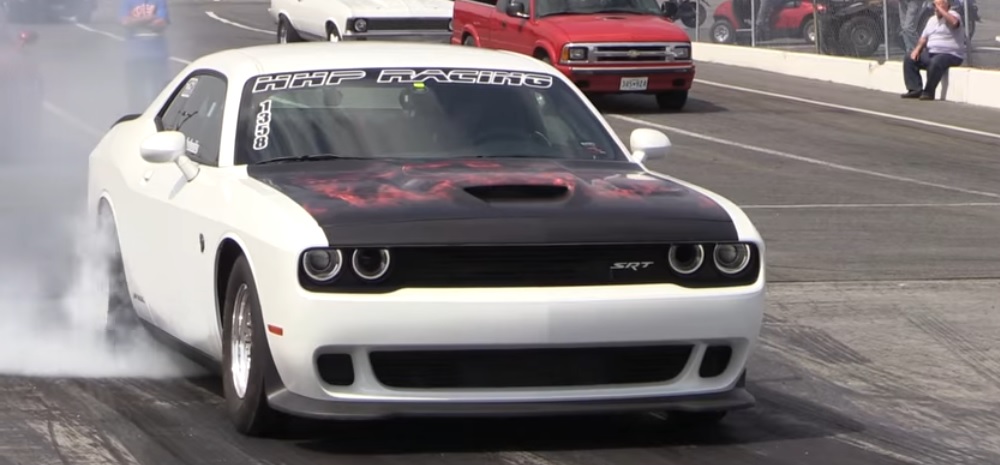How to Make a Dodge Challenger Hellcat Quicker Than a Demon
The Dodge Demon does the 1/4-mile in 9.65 seconds. Here's what it takes to go quicker in a "regular" Hellcat.

"To get a standard Hellcat up to Demon levels, it's really just turning up the boost, doing exhaust work, intake work and tuning," Schwartz told me over the phone. Add in a gearing swap, from the factory 2.62:1 final drive to a shorter 3.09, and you're in the Demon's neighborhood. "We have a ton of customers where we take them from 11 psi, the factory boost, to 15 psi, retune them with exhaust work, then gears, drag radials, and on their race gas tune typically they'll run 9.80 with full-weight Hellcats." Strip out the 200-plus pounds of weight that the Demon sheds, and you're well on your way to 9.65, Schwartz says.
But you'll need plenty of practice to do it. High Horse's developments are all real-world tested on the shop's white Challenger Hellcat. Nicknamed "TopCat," it currently runs a 9.15-second quarter-mile on stock engine internals and the factory ZF eight-speed automatic transmission. "When the car was running 9.5s, 9.6s, it took me a month and a half, eight trips to the track, before I learned how to launch the car," Schwartz told me. His best times are achieved by loading the torque converter at the line, releasing the brake, then patiently adding in throttle. "As I feel the rear end squat, I can just roll in quicker on the gas pedal, but I have to initiate that weight transfer myself," Schwartz said.
Schwartz said his shop is experimenting with suspension upgrades to help with weight transfer, and his TopCat runs with a race seat, race fuel, the NHRA-mandated chute, and drag radials. The Demon's combination of launch control, trans brake, and suspension-assisted weight transfer likely make a measurable difference in the car's drag strip performance, Schwartz said.
So, what would it cost to build up a Demon-chasing Hellcat? High Horse offers a package with 18 psi of supercharger boost, a race gas tune, drag radials, swapped rear end gears, and exhaust upgrades. "It's right around a $10,000 package," Schwartz says, "and with drag radials we had a bunch of guys last year running in the 9.5 to 9.7 range consistently." Such a setup usually nets around 800 rear-wheel horsepower, Schwartz says, though he prefers to go by drag strip times over chassis dyno numbers.
A base-model Challenger SRT Hellcat with an automatic transmission skates in at just under $69,000. Add ten grand for High Horse's upgrades and tuning expertise, and you're running mid-nines for right around 80 grand. With the Demon expected to come in at just under $100,000, the savings adds up to a whole bunch of spare rear tires. So why spring for the Demon at all?
"I think the fact that it has a warranty is huge," Schwartz says. "That alone, to a lot of our customers, is really a huge selling point, because pretty much everything I do, I'm voiding the warranty on that car." Add in the super-limited production numbers—3000 Demons slated for the US, 300 for Canada, one model year only—and the peace of mind of knowing your speed equipment is street legal and engineer tested, and suddenly that factory-built drag racer begins to make sense.
Not that Schwartz and the High Horse Performance team are worried. "We're hoping that once the Demon comes out, we'll get a nice influx of them through our shop for roll cages to make them NHRA legal," he said. And perhaps some of those Demon owners will ask him to add a few horses on top of the 840 that Dodge offers. "I don't know how aggressive they were, if they left horsepower on the table," he said. "There might still be some room in there for tuners like myself to get our hands on the cars and turn it up a little bit more."
http://www.roadandtrack.com/new-cars/news/a33293/how-to-make-a-dodge-challenger-hellcat-quicker-than-a-demon/